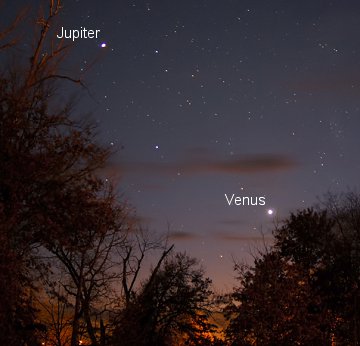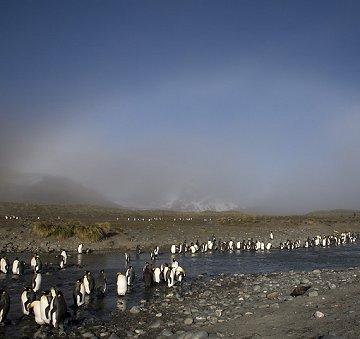| SEE THE SPACE STATION: Space shuttle Endeavour docked to the International Space Station on Sunday, Nov. 16th, delivering a new crew member and 14,000+ pounds of equipment and supplies to the outpost. Joined together, the two spacecraft are among the brightest objects in the night sky, rivaling Venus in luminosity. Check the Simple Satellite Tracker for flyby times. photos: from Mark Staples of Gainesville, Florida; MICRO-MOON OF VENUS: Tonight, Venus is passing just 0.1o below 3rd-magnitude star Lambda Sagittarii. Viewed through binoculars or a small telescope, Venus appears to have gained a moon--a remarkable sight. Finding Venus is easy. Go outside at sunset and look southwest. Venus is one of two bright lights shining through the cobalt-blue: 
Dan Bush took the picture on Nov. 15th from his backyard in Albany Missouri. "The clouds parted just long enough for a 15 second exposure with my Nikon D200." Readers, you'll want to keep an eye on this patch of sky in the nights ahead. Venus and Jupiter are rushing together, drawing noticably closer every night. The climax occurs at the end of the month when, with the two planets only 2o apart, the crescent Moon leaps up from the horizon to join them for a three-way conjunction of rare and spectacular beauty. Stay tuned! Sky maps: Nov. 17, 18, 19, 20, 21, 22, 23, 24, 25, 26, 27, 28, 29, 30, Dec 1. more photos: from Daniel Strehle of Augsburg, Bavaria, Germany; from Jesus Pelaez Aguado of Burgos, Spain; from Steve Holmes of Laxfield, Suffolk UK; from Mila Zinkova of San Francisco, California; from Tamas Ladanyi of Veszprem, Hungary; from Becky Ramotowski of Tijeras, New Mexico; from Martin Popek of Javorový, Czech Republic; from Alex Roca of Hortoneda, Lerida, Spain; from Val Germann of Columbia, Missouri; SOMETHING FISHY IN THE SKY: When you run into a thousand penguins all staring at the sky, two words come to mind: flying fish. But on Oct. 28th, photographer Steve Shuey caught the flightless birds of South Georgia Island staring up at something else: atmospheric optics. "The sun had just risen," he says, "when this fogbow appeared in the mist." 
Photo details: Canon 5D, ISO 160, 1/500th sec, f/11
"A fogbow is like a rainbow except that the fog droplets making them are a hundred times smaller than raindrops," says atmospheric optics expert Les Cowley. "They are too small for light waves to pass through them in the straight lines of geometric optics and wave interference smears the bow into a broad band. You do not need to be in penguin-land to see them. Look for fogbows whenever a low sun starts to shine through morning mist."
Nov. 2008 Aurora Gallery
[Previous Novembers: 2007, 2006, 2004, 2003, 2001, 2000] | 
